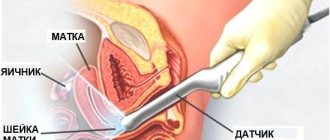Already from the first days of pregnancy, the female hormonal background begins to change rapidly, and the transformations affect all areas of the body. Beige discharge during pregnancy is considered quite common, which usually occurs under the influence of the progesterone hormone. But sometimes an unusual shade or unpleasant odor may accompany the beige smudge, which indicates that the discharge is abnormal. How to figure out which leucorrhoea and secretions are considered normal during pregnancy, and which indicate pathology.
The right approach to planning will help avoid complications during pregnancy
A little theory
In fact, beige discharge in early pregnancy is not uncommon. It is not dangerous, although the doctor’s attention should be drawn to this fact. It is much worse when there is brown discharge. Especially if they arise unexpectedly and are accompanied by pain in the lower abdomen. This may be a symptom of an ectopic or frozen pregnancy or miscarriage. Although light brown discharge in the early stages can be observed on the days when your period was supposed to start. This is a sign that the body has not had time to rebuild and adapt to its new state. In this case, the symptom is not dangerous, but you need to see a doctor.
The second option is white discharge. Abundant, curdled, with a sour smell - these are symptoms of thrush. Fungi such as Candida are to blame for this. Treatment is complicated by the fact that many drugs are prohibited until the beginning of the second trimester.
Scarlet and red discharge, as in the case of brown, are normal only if they are not accompanied by pain, and also if this phenomenon coincides with the onset of menstruation. Yellow, thick - this is a symptom of cervical erosion or an inflammatory process.
Normal discharge
The first weeks after fertilization are of the utmost importance for the baby, because it is during this period that it attaches to the uterine wall and begins to actively develop, forming into a tiny person. During this period, the mother’s body can present many surprises, such as unusual painful sensations in the uterine area, morning sickness or unusual spots on the underwear.
- Progesterone begins to be actively produced, which increases vaginal secretion, so the appearance of beige spotting in the early stages of pregnancy is not considered something unusual or supernatural.
- Moreover, these secretions have important functional significance, because they moisturize the organs of the reproductive system.
- The appearance of a light beige secretion in the first month of gestation indicates the beginning of the formation of placental tissues and mucous plug, which will protect the baby from the penetration of infectious agents, bacterial microorganisms, fungi and other aggressive and dangerous substances throughout pregnancy, ensuring its comfortable development.
- On the days when the patient begins her period, beige discharge may also appear in the early stages of pregnancy, containing minor bloody streaks. This phenomenon is also considered completely natural, and over time such daubing will stop.
- In addition, minor brownish stains on underwear may be detected after a gynecological examination or ultrasound examination. It’s just that the genital tract loosens somewhat, so it becomes sensitive to any contact.
- Sometimes beige discharge during pregnancy is the result of an allergic reaction to the used underwear made of synthetic materials, soap or gel for the intimate area, powder, etc. By stopping the use of the allergen, the problem itself will be eliminated.
All these discharges are considered completely normal and should not cause any concern. If mommy experiences severe discomfort, then you can use sanitary pads, just choose thin ones without any fragrances.
What can be considered normal
Beige discharge before menstruation is a very common phenomenon. In most cases, this indicates the implantation of the fertilized egg into the wall of the uterus. Then there should be no nagging pain, itching or other symptoms. It is these calls that require immediate contact with a doctor, since it may be about saving the mother’s life.
Why did the question of discharge during pregnancy even arise? Maybe they simply shouldn’t exist, and only in this case should we assume that the expectant mother’s condition is normal? No, this position is wrong. The fact is that changes in hormonal levels occur already in the very early stages of pregnancy. In this case, viscous and opaque discharge appears. They should not have a distinct color, odor or cause discomfort. In this case, we can say that the body responded correctly to pregnancy. This phenomenon is considered normal for the first three months, and this occurs due to the hormone progesterone. The cervix is completely closed with a special mucus plug. This ensures the safety of the embryo, since infections from the outside world do not penetrate to it.
Thus, we are gradually approaching the fact that not all discharge can be classified as normal. The first thing that should alert you is a change in color and smell. For this, it is important for the expectant mother to use sanitary panty liners. Beige discharge can easily get lost on your laundry, and you will miss important signals from your body.
Brown discharge during pregnancy
In practice, brown spotting during pregnancy is very, very common. Not in all cases this portends danger and promises problems with pregnancy.
But doctors absolutely always urge women in such situations to seek medical advice: spotting of any color, quantity and consistency at different stages of pregnancy can represent a real danger.
Actually, the biggest difficulty is this: there are a number of reasons why spotting in the early and late stages of pregnancy is considered a physiological norm, but there are also many situations where they are a sign of a serious disorder. Therefore, never make hasty conclusions and always confirm your guesses or fears in the gynecologist’s office.
If not in most cases, then at least very often women are worried about this phenomenon in the early stages of pregnancy. Moreover, it can occur already in the very first days and weeks - at 3, 4, 5, 6 weeks. Sometimes it seems that this is the beginning of menstruation, or that a brown spot appears instead of menstruation.
Most likely, this is implantation bleeding, which occurs between 6 and 14 days after conception: at this time, the fertilized egg is attached to the walls of the uterus, which may be accompanied by a slight discharge of blood of any color and barely noticeable pain in the lower abdomen from the implantation side. Most often, implantation bleeding has a pale color - pinkish, cream, beige, light brown. It looks like minor admixtures of blood to normal vaginal leucorrhoea.
Since with the onset of conception, the hormone progesterone begins to dominate in the body of a pregnant woman, creating in it all the conditions necessary for the preservation and development of pregnancy, under its influence, light brown discharge can occur from time to time at different stages of pregnancy, starting from the beginning - 9, 10, Week 12. They are minor and are not accompanied by pain or other discomfort. May resemble discharge, like on the last day of your period. Also, such a symptom may indicate progesterone deficiency, and in this case, pregnancy is in danger of failure.
Some women normally develop brown spotting in the form of ichor (the so-called “daub”) in the first trimester - on the days of expected menstruation.
In most cases, light brown discharge is not dangerous, but there may still be risks . But if you observe dark brown discharge during pregnancy, and especially if it is accompanied by other dangerous symptoms, then you should contact a gynecologist immediately.
Dangerous brown discharge during pregnancy
It is very difficult, and even almost impossible, to independently reliably determine the cause of this phenomenon. This is exactly the case when it is better to play it safe and go for an examination to a doctor.
There are often cases when blood from the vagina during pregnancy, including brown blood, indicates a threat of miscarriage, which often occurs in the very early stages. It is possible that the pregnancy develops ectopically: in this case, it will have to be terminated .
If, along with this symptom, other signs of ectopic pregnancy appear, then under no circumstances should you hesitate: every minute counts!
If you complain of brown vaginal discharge, your doctor will likely refer you for an ultrasound to diagnose your condition more accurately.
Ultrasound can detect disorders and pathologies that require immediate medical attention:
- ectopic pregnancy: when the fertilized egg is fixed in a place not suitable for its further development;
- detachment of the ovum: when an already attached embryo begins to be rejected by the maternal body, as a result of which spotting occurs;
- placental abruption or placenta previa: observed in later stages and also threatens pregnancy by interruption or premature onset of labor. In this case, dark brown discharge during pregnancy will be accompanied by pain in the lower abdomen;
- frozen pregnancy: with intrauterine death of the fetus, the body will begin to try to get rid of it, which is accompanied by a number of characteristic signs, including bleeding.
Any of these conditions require immediate medical attention. And only a specialist can confirm any of them. Therefore, to remain inactive or rely on one’s own guesses is, at the very least, irresponsible. Brown discharge during pregnancy should cause the most concern if at least one other symptom is present at the same time:
- nausea and vomiting appear;
- dizziness and fainting are observed;
- severe weakness is felt;
- chills occur;
- profuse bleeding;
- accompanied by pain in the abdomen or lower back, radiating to the rectal area.
Do you experience brown discharge during pregnancy, along with stomach pain, nausea, and dizziness? Go to the doctor! And let him reassure you that this is just a “side effect” of your condition and does not threaten you or the baby in any way. God willing. In the meantime, exclude any physical activity: strict bed rest is indicated. In this case, it is better to place your legs on a hill.
Brown discharge in late pregnancy
We have not yet mentioned that the cause of brown blood from the vagina may be some diseases of the woman’s genitourinary system. Also, with cervical erosion, this phenomenon is not at all uncommon. In this case, brown spotting may appear due to mechanical impact on the cervix: after sexual intercourse, after a gynecological examination, etc.
In itself, neither erosion nor the discharge resulting from it poses any great threat, but after childbirth the disease will have to be treated if it does not disappear on its own.
If spotting occurs at 38-39 weeks of pregnancy, then there is a very high probability that this is a mucus plug coming off. It looks like a piece of clear or whitish mucus, which may contain streaks of blood.
Sometimes the plug comes off gradually, in parts (minor mucous discharge) or all at once (in the form of a clot of dense mucus), but this is always a harbinger of imminent labor: it can begin after a few hours or only after a few days or even weeks.
Especially for nashidetki.net - Elena Semenova
Source: https://nashidetki.net/lechenie-pri-beremennosti/korichnevye-vydeleniya-pri-beremennosti.html
Let's understand the details
Progesterone is a hormone that completely regulates the functioning of the uterus in the first three months of pregnancy. The nature of the discharge mainly depends on it. If enough of it is produced, whitish or transparent mucus will be present. As we have already said, progesterone creates a plug to protect the embryo from any dangers from the environment. However, its deficiency or excess can greatly change the nature of the discharge. During this period, the placenta is formed and the embryo itself is fixed, and unstable hormonal levels can provoke various disorders, including miscarriage.
The beige discharge often contains streaks of blood. A small amount of it gives the mucus a similar color. In this case, I would again like to note that if there is no pain, then you can limit yourself to increased control. To do this, be sure to use sanitary pads, but in no case tampons, which themselves can contribute to the development of infection. Already in the second trimester, the amount of estrogen in the blood will increase, which makes the discharge more liquid and viscous.
Danger of inflammatory process
It cannot be excluded without a special examination. Beige discharge in the early stages of pregnancy can be either a variant of the norm or indicate hidden inflammatory processes that are activated due to decreased immunity. This problem is easier to prevent than to treat. To do this, even at the stage of pregnancy planning, it is necessary to undergo special examinations.
But often doctors are faced with a different situation. A woman turns to a consultation when she is already pregnant, when all her chronic diseases become aggravated. All that remains is to undergo an examination and choose the most gentle treatment methods. However, beige discharge in the early stages of pregnancy does not indicate a serious pathology; the condition can be corrected by an experienced doctor with minimal use of medications.
What to do if uncharacteristic discharge appears?
Timely examination by a specialist can prevent many negative consequences for the mother and her child. That is why any changes should be immediately reported to the gynecologist. If you are not sure that the discharge that appeared a couple of times was the result of a normal physiological process, the doctor will dispel your doubts with the help of a series of tests. Or, on the contrary, it will confirm fears by prescribing appropriate therapy.
You should be wary if the discharge does not go away for a long time and takes on a strange shade. Dangerous colors include brown, bloody and, especially, greenish. The latter, most often, is evidence of the onset of an infectious process. In this case, you should immediately contact the antenatal clinic and undergo appropriate research.
Most often, beige and creamy discharge in early pregnancy is not a harbinger of serious problems. But this is only if they pass without signs characteristic of the pathological condition. Listen to your feelings and watch for symptoms. Don't panic right away. Stress is bad for your condition.
Signs of inflammation
How can a woman understand that the situation requires immediate intervention from a specialist? After all, as we have already said, beige discharge in the early stages is a fairly common phenomenon. In fact, you only need to carefully monitor the condition of your body. If up to a certain point the discharge was transparent, and suddenly changed color, then you need to be wary. If implantation bleeding occurs, that is, the implantation of the embryo into the wall of the uterus, the situation returns to normal the very next day. And then in this case, what is more often observed is not light beige discharge, but rather reddish discharge, similar to menstrual discharge. If the color changes, and along with it an unpleasant odor or pain appears, then it’s time to sound the alarm.
Necessary tests
The listed symptoms plus beige discharge give the doctor reason to suspect that there is some kind of infection in the body. No one will treat a pregnant woman at random, so diagnostic examinations are necessary. Such changes may be symptoms of cervical disease. A simple smear can reveal the reason for the changes, and you should take it immediately if you suspect something.
The earlier the better
It would seem that right now the female body should mobilize its strength as much as possible, because there is absolutely no time for illnesses. But in practice it turns out a little differently. During the period of bearing a baby, a woman’s body is so loaded that she no longer has the strength to rely on her own immunity. As a result, the likelihood of infection increases several times. Not only beige discharge during pregnancy in the early stages should alert a woman. Any discomfort in the abdomen or external genitalia is a reason to visit a doctor. If the cause is an infection and it is caused by dangerous bacteria, then this is fraught with miscarriage or pathology of fetal development. Therefore, you cannot delay examination and treatment.
What does beige discharge mean in pregnant women?
Already from the first days of pregnancy, the female hormonal background begins to change rapidly, and the transformations affect all areas of the body.
Beige discharge during pregnancy is considered quite common, which usually occurs under the influence of the progesterone hormone.
But sometimes an unusual shade or unpleasant odor may accompany the beige smudge, which indicates that the discharge is abnormal. How to figure out which leucorrhoea and secretions are considered normal during pregnancy, and which indicate pathology.
The right approach to planning will help avoid complications during pregnancy
Normal discharge
The first weeks after fertilization are of the utmost importance for the baby, because it is during this period that it attaches to the uterine wall and begins to actively develop, forming into a tiny person. During this period, the mother’s body can present many surprises, such as unusual painful sensations in the uterine area, morning sickness or unusual spots on the underwear.
- Progesterone begins to be actively produced, which increases vaginal secretion, so the appearance of beige spotting in the early stages of pregnancy is not considered something unusual or supernatural.
- Moreover, these secretions have important functional significance, because they moisturize the organs of the reproductive system.
- The appearance of a light beige secretion in the first month of gestation indicates the beginning of the formation of placental tissues and mucous plug, which will protect the baby from the penetration of infectious agents, bacterial microorganisms, fungi and other aggressive and dangerous substances throughout pregnancy, ensuring its comfortable development.
- On the days when the patient begins her period, beige discharge may also appear in the early stages of pregnancy, containing minor bloody streaks. This phenomenon is also considered completely natural, and over time such daubing will stop.
- In addition, minor brownish stains on underwear may be detected after a gynecological examination or ultrasound examination. It’s just that the genital tract loosens somewhat, so it becomes sensitive to any contact.
- Sometimes beige discharge during pregnancy is the result of an allergic reaction to the used underwear made of synthetic materials, soap or gel for the intimate area, powder, etc. By stopping the use of the allergen, the problem itself will be eliminated.
All these discharges are considered completely normal and should not cause any concern. If mommy experiences severe discomfort, then you can use sanitary pads, just choose thin ones without any fragrances.
Beige discharge as a sign of inflammation
But sometimes beige discharge during pregnancy in the early, first weeks can be a sign of inflammatory processes in the genitourinary system that occur latently.
They can be activated against the background of the traditional decrease in immune defenses at the beginning of gestation. It is better to prevent such problems in advance rather than treat them after conception.
After undergoing a thorough examination and taking a smear and blood test for hidden infections, you can easily detect such pathologies and treat them in a timely manner, even at the planning stage.
Great happiness in the family - the birth of a healthy baby
Often the situation is of a slightly different nature, when the girl has already conceived, her immunity has weakened, and hidden sores have begun to appear. In such a situation, beige discharge during pregnancy can only be eliminated using the most gentle methods for the fetus.
How can you understand that inflammation is raging in your body and you can’t cope with it without the help of a doctor? In general, beige daub can be of harmless origin.
You just need to closely monitor your health, and if spotting suddenly becomes abundant, acquires a suspicious hue or an unpleasant odor, immediately consult a doctor.
If minor blood impurities are caused by implantation processes, then within a day all suspicious symptoms will disappear. By the way, many mothers often confuse such discharge with the beginning of menstruation.
If the intensity of such discharge does not decrease, the color only becomes more saturated and a nauseating odor appears, but an urgent examination is necessary.
The doctor will prescribe the laboratory tests necessary for diagnosis, because no specialist will treat a pregnant patient at random.
Such discharge can occur against the background of various conditions, for example, cervical pathologies, which can be identified by a regular gynecological smear.
It is during this period that the patient’s body is extremely overloaded, all its resources are aimed at the formation, preservation, gestation and provision of the fetus with everything necessary, and there is nothing left for its own needs. As a result, a woman becomes defenseless against various types of dangerous and unwanted infections during pregnancy.
Any deviation from normal indicators, be it color, smell, consistency of discharge - all this requires medical consultation. This is necessary, because some infections can lead to spontaneous abortion or fetal pathologies.
What infections should be avoided?
We are talking about the very early weeks, when the patient may not yet know about conception, but sexual intercourse has taken place and now she is delayed. If a girl has unusual and unpleasant-smelling beige discharge, then it should be perceived as an alarming sign, because it may indicate infectious pathologies such as:
- Vaginal dysbiosis. It is characterized by the presence of viscous, thick and dark discharge, which occurs against the background of disturbances in the vaginal microflora.
- Inflammation of the cervical canal. The shade of mucus in such a situation will vary according to the type of pathogen that provoked the pathology.
- Inflammatory lesions of the fallopian tubes are also accompanied by unusual spotting. In this case, discharge during pregnancy in the second trimester and in its first weeks may acquire a beige, red or yellowish tint and is often accompanied by painful sensations in the abdominal area.
- Infections of sexually transmitted origin (trichomoniasis, gardnerellosis, gonorrhea, etc.) can also occur during pregnancy, while smelly purulent impurities will be present in the mucus, fever or slight hyperthermia may be a concern.
It is impossible to independently determine the true cause of the discharge; only laboratory tests will help to accurately determine the source of inflammation and its nature.
If the discharge is yellow
The expectant mother should be under constant medical supervision
A dangerous sign is the appearance of yellow or beige-green discharge in the first weeks. They may bubble, and a rich beige-yellow hue indicates the presence of a large amount of pus in them. Typically, such discharge is a sign of the development of an acute infection or STD.
In the first months of gestation, fungal and infectious pathologies are especially dangerous for the embryo that has begun to develop, because the placental barrier is finally formed only at the beginning of the second trimester, and until that time all pathogenic microorganisms are able to freely leak into the baby’s bloodstream. Therefore, urgent treatment is necessary.
The appearance of beige-yellow discharge may indicate the development of vaginal infectious pathologies.
With trichomoniasis, patients note the appearance of light beige or light yellow discharge with a nasty odor, and with chlamydia - beige-yellow or brown with characteristic pain in the abdomen.
Gonorrhea is manifested by light yellow secretion, urination with cramps and pain in the abdomen, and colpitis is manifested by watery yellowish-green foul-smelling discharge, fever and pain in the genitourinary area.
When prescribing treatment, patients face a serious problem. Pregnant girls should not take all medications in a row, because they also penetrate into the fetal bloodstream. Therefore, selecting safe medications for pregnant women is an extremely responsible and difficult task, and in the early stages almost impossible.
But self-medication or delaying therapy is no less dangerous. A special category is represented by patients who deliberately refuse to take medications, trying in this way to protect the baby. They can be understood, because today everyone knows about the dangers of pills for pregnant women.
But the danger of intrauterine infections is much higher than taking medications to eliminate these same infectious processes.
When to worry
To avoid the threat of miscarriage, inflammatory or infectious pathologies, a girl during pregnancy must undergo timely laboratory tests of blood, urine, smears for the presence of hidden infections and the nature of the vaginal microflora.
You must also undergo all routine gynecological and obstetric examinations, ultrasound examinations and other diagnostic examinations.
Such measures are extremely important in order to promptly detect the activity of pathogenic bacteria and destroy them at the earliest stage of their development.
- If the discharge has changed in consistency, shade or intensity, this does not indicate the development of a serious disease.
- However, if these signs are accompanied by a fetid or nauseating odor, burning-itching discomfort in the perineum and pain symptoms appear, then urgent measures need to be taken.
- The first step is to contact a specialist who will determine the true causes of changes in vaginal changes.
- The main sign of pathology is a sudden change in color, smell and consistency that occurs simultaneously. Usually, a smear test for microflora is sufficient to diagnose the cause.
- If the developed inflammation has worsened, then the discharge may also remain beige, however, itching in the genitals and painful urination are added to it. Such symptoms often indicate infection with an STD.
- If the beige discharge changes to brown, blood streaks appear or bleeding begins, then urgent intervention by specialists is necessary. Similar symptoms manifest themselves in ectopic pregnancy, detachment of placental tissue or exacerbation of cervical erosion.
Pregnant women need to remember that a beige secretion without pain, odor, bloody impurities and with a uniform consistency is considered normal. Excessive abundance, unpleasant odor, itching and burning in the perineum, abdominal pain - these symptoms are pathological in nature and therefore require urgent diagnosis and treatment.
What tests to take
You must follow all recommendations of your doctor
First of all, if beige discharge is detected, the patient needs to undergo a blood test for progesterone levels, because this sign sometimes indicates a deficiency of such a hormone.
Progesterone is very important for a pregnant woman, because if it is insufficient, there is a threat of early pregnancy failure, delayed fetal development and other pregnancy problems.
But this study requires certain preparation; only then the data obtained will be reliable.
Test results can be affected by taking medications that change hormonal levels, as well as some foods that can stimulate nervous system activity. Therefore, it is necessary to discuss with your doctor all the medications the girl is taking.
In addition, the day before donating blood, you need to exclude alcohol, tea, coffee and spicy foods from your diet.
Progesterone can increase under the influence of fatty foods, so approximately 3-4 days before donating blood, you should give up fatty meat and high-fat dairy products, caviar and eggs, as well as vegetable fats.
A blood test to determine progesterone levels must be taken on an empty stomach in the morning. If you can donate blood only during the day, then you can have a light breakfast in the morning, the main thing is that at least 6 hours pass from the moment you eat before donating blood. But drinking ordinary water is not prohibited.
Dangerous infections
Do not forget that we are now talking about the very early period of pregnancy, when the expectant mother does not always know that a small miracle is being born inside her. But if you are sexually active and experience a delay, beige discharge should alert you. Among the dangerous ailments that require immediate correction are:
- Venereal diseases. In this case, the beige discharge contains impurities of pus. Accordingly, they are accompanied by an unpleasant odor and sometimes an increase in temperature.
- Vaginal dysbiosis. In this case, the mucus changes, becoming darker, thicker and more viscous. The reason lies in the disruption of the vaginal microflora.
- Inflammation of the fallopian tubes also changes the nature of the discharge. They may turn yellow, reddish or beige. Often accompanied by pain in the lower abdomen.
- Inflammation of the cervix. The color of the mucus may change depending on what pathogen was responsible for the incident.
- As you can see, there are quite a lot of reasons, and you won’t be able to diagnose yourself. Even if you did not plan pregnancy, but do not exclude the possibility of its occurrence, be sure to visit a doctor without delaying matters.
Light yellow, beige, yellowish odorless discharge during pregnancy
Light yellow discharge is most often visualized during the first 3 months of pregnancy. This process is natural and is often caused by an increased level of progesterone (a steroid hormone) in a woman’s body. It activates blood circulation in the pelvic area and provokes the formation of secretion in large volumes.
Photo gallery: discharge during pregnancy
Light yellow discharge may appear due to the formation of a lump of high-density mucus in the cervix. If a woman is not bothered by the symptoms characteristic of pathologies: itching, burning, pain, discomfort, then most likely the secretion is a manifestation of physiology. At the end of 3 months of pregnancy, the amount of mucus should decrease. This is typical for most cases.
Intense yellowish discharge may be normal, but only if it is not accompanied by unpleasant symptoms. Abundant secretion is typical for many women during pregnancy. The walls of the uterus soften, and the composition of the vaginal environment changes. Increased secretion is necessary for the birth process to go smoothly.
Finally about the most important
The most difficult situation is for those women whose pregnancy occurred at the beginning of the cycle. The period has just passed, the first signs are still far away, and the expectant mother is not even aware of her situation. Therefore, doctors never tire of repeating that beige discharge after menstruation, pain, or any discomfort should be the reason for an immediate trip to the local gynecologist. Everything we talked about above is subject to correction, but there are more dangerous cases.
Emergency assistance required
Beige mucus in the early stages of pregnancy may indicate egg detachment. In this case, some vessels are damaged. But these are just the first signs, and if you don’t see a doctor in time, you can end up in the hospital for a long time. In the case of an ectopic pregnancy, beige discharge may also be the first sign, but it will quickly turn into heavy bleeding, accompanied by severe pain.
Sometimes similar symptoms are caused by cervical erosion. Sores and wounds on the inflamed area contribute to the production of mucus, which is accompanied by itching and discomfort. During pregnancy, drug treatment is recommended, and after the birth of the baby, the mother will be offered cauterization.
Yellow discharge in early pregnancy is normal
Experts clearly agree that yellow discharge may be physiological or normal for a pregnant woman’s body. However, this is only possible if the following conditions are met:
- the discharge has a light yellow or cream tint;
- there are no sharp or unpleasant odors;
- discomfort in the form of burning and itching in the vaginal area and vulvar mucosa (external genitalia) is excluded;
- There are no signs of intoxication or other pathological symptoms.
Yellow discharge can signal changes occurring in a woman’s body: a cervical mucus plug is formed and hormonal changes are observed. If yellow discharge appears during pregnancy, but there are no other negative symptoms or unpleasant odors, then this is a physiological norm.
If yellow discharge appears during pregnancy, but there are no other negative symptoms, then they are usually considered to be a physiological norm. However, consultation with a specialist is necessary in any case, since not all diseases manifest themselves clearly.
Yellow discharge can be formed due to the individual characteristics of a woman’s body or be considered as a relative norm, namely, the result of non-compliance with intimate hygiene, or its irregularity.
The appearance of a yellow tint can also be affected by:
- products used for personal hygiene of intimate areas;
- synthetic underwear;
- panty liners that are impregnated with chemicals or aromatic substances.
Table: yellow discharge is normal by week
| Week of pregnancy | Discharge is normal |
| week 6 | It is normal if the discharge is clear and uniform in structure and is not accompanied by an unpleasant odor, itching, pain or other discomfort. |
| week 7 | If the discharge is not accompanied by clinical symptoms, then this is normal. At this stage, they may be mucous and vary in abundance. The dynamics of the structure of the secretion, its color and the appearance of an unpleasant odor is a bad sign that requires the intervention of specialists |
| 8 week | Discharge in moderate quantities, without an unpleasant odor, which is not accompanied by itching and other discomfort can be considered the norm. During this period, pregnant women often develop thrush. This occurs because the pH in the vagina becomes more acidic in an attempt to protect the fetus from various infections, and immunity decreases. Watery, yellowish discharge may appear due to leakage of amniotic fluid. If the secretion has a sweetish odor, then you should immediately consult a doctor |
| Week 9 | For this week, clear yellowish secretion is normal, without impurities or foreign odors. |
| 10 week | Yellow discharge during this period should have a uniform structure, be moderate and light in color. Other clinical symptoms are an indicator of the development of pathology |
| 11–12 weeks | Secretion without discomfort in moderate quantities is quite acceptable |
| Week 13 | During this period, discharge may become thinner as the young mother’s body begins to actively produce estrogen (a hormone produced by the ovaries), which helps thin the mucus. |











